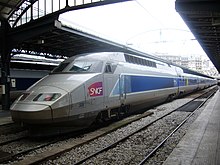Rail transport in France
| Rail transport in France | |||||
|---|---|---|---|---|---|

TGV at Paris-Est station
|
|||||
| Operation | |||||
| National railway | SNCF | ||||
| Infrastructure company | SNCF | ||||
| Major operators | Thalys, Lyria, Eurostar, RATP, Elipsos, ECR | ||||
| Statistics | |||||
| Ridership | 1,122 million (2014) | ||||
| Passenger km | 83.9 billion (2014) | ||||
| Freight | 32 billion tonne-km (2014) | ||||
| System length | |||||
| Total | 29,901 kilometres (18,580 mi) | ||||
| Double track | 16,445 km (10,218 mi) | ||||
| Electrified | 15,140 km (9,410 mi) | ||||
| High-speed | 1,876 km (1,166 mi) | ||||
| Track gauge | |||||
| Main | 1,435 mm (4 ft 8 1⁄2 in) | ||||
| High-speed | 1,435 mm (4 ft 8 1⁄2 in) | ||||
| Electrification | |||||
| 25 kV AC | 9,113 km (5,663 mi) | ||||
| 1500 V DC | 5,905 km (3,669 mi) | ||||
| other | 122 km (76 mi) | ||||
| Features | |||||
| No. tunnels | 1,300 | ||||
| Tunnel length | 540 km (340 mi) | ||||
| Longest tunnel | 50.5 km (31.4 mi) (Channel Tunnel) | ||||
| Longest bridge | 2.178 km (1.353 mi) (Saint-André-de-Cubzac bridge) | ||||
| No. stations | 3,054 (2009). | ||||
| Highest elevation | 1,593m (Yellow Train) | ||||
|
|||||
| Map | |
|---|---|
 |
Rail transport in France is operated mostly by SNCF, the French national railway company. France has the second largest European railway network, with a total of 29,901 kilometres of railway. However, the railway system is a small portion of total travel, accounting for less than 10% of passenger travel.
Since 1981, the SNCF has operated the TGV service, a high-speed rail network which has been consistently expanded in subsequent years.
France is a member of the International Union of Railways (UIC). The UIC Country Code for France is 87.
The history of rail transport in France dates from the first French railway in 1832.
Since Legrand Star rail plan of 1842, French railway is highly polarized by Paris.
Traffic is concentrated on the main lines: 78% of activity is done on 30% of the network (8,900 km) when the 46% smaller lines (13,600 km) only drive 6% of the traffic. The 366 largest stations (12%) make 85% of passenger activity, and the smallest 56% of stations take only 1.7% of traffic.
Freight transport has declined since the early 1980s. Today the network is predominantly passenger centric.
Since January 1 2007, the freight market has been open to conform to European Union agreements (EU Directive 91/440). New operators had already reached 15% of the market at the end of 2008.
The Transport express régional (TER) is directed by the administrative Regions of France. They contract with the SNCF for lines exploitation.
The SNCF directly manage this class of trains. The TGV is used on the most important destinations, while Intercités carriages are still used for other lines.
The French railway network, as administered by SNCF Réseau, as of June 2007, is a network of commercially usable lines of 29,213 kilometres (18,152 mi), of which 15,141 km (9,408 mi) is electrified. 1,876 km (1,166 mi) of those are high speed lines (LGV), 16,445 km (10,218 mi) dispose of two or more tracks. 5,905 km (3,669 mi) are supplied with 1,500 V DC, 9,113 km (5,663 mi) with 25 kV AC at 50 Hz. 122 km (76 mi) are electrified by third rail or other means.
...
Wikipedia
